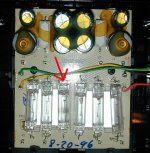OK understood.
Found some broad transient duration figures in following
maximum sustained peaks seems to be around 60ms.
sound quality for such method and implementing such scheme makes it uncertain as music itself can be dynamicaly complex with sustained peaks. As you said better to have good Transformer, PS and output.
regards.
Found some broad transient duration figures in following
sound quality for such method and implementing such scheme makes it uncertain as music itself can be dynamicaly complex with sustained peaks. As you said better to have good Transformer, PS and output.
regards.
Bear in mind that the video is mostly about instrument amplifiers and live sound effects, which may be intentionally extreme, involving high distortion and other special effects. This is a different purpose to hi-fi, music recording playback, broadcast and sound distribution etc. where the plan is generally to maintain the input audio quality or signal integrity at 100%, right through to the speaker terminals - the only changes being to increase the power level and reduce the output impedance to suit the load.
Will never know if not asked so...
Having a sensing transistor/circuit to sense the peaks and switching the PS lines would that be detrimental to sound quality ?
Having a sensing transistor/circuit to sense the peaks and switching the PS lines would that be detrimental to sound quality ?
Any circuit in series between amp output and speaker-problematic, in parallel with speaker but high impedance or buffered (e.g. level meter, multimeter or a scope) is kinda OK
Last edited:
I saw the same trick with 12 volts auto brake light used in crossover to protect tweeters. ( low cost speaker )
Hammond organ also used lightbulb in reverb circuit to limit power send to spring unit I think.
Hammond organ also used lightbulb in reverb circuit to limit power send to spring unit I think.
By definition, a voltage sensing circuit should not load or disturb the operation of the device under test, in any significant way. If you used an external oscilloscope or digital peak meter to measure the signal, the very high impedance of the instruments should certainly not affect the very low impedance output of a power amplifier - assuming suitable test leads or other alterations to the circuit are also appropriate for the purpose.Will never know if not asked so...
Having a sensing transistor/circuit to sense the peaks and switching the PS lines would that be detrimental to sound quality ?
For many years, there have already been low cost hifi and PA amplifiers models with 2 or more switched or variable power rail levels. It saves power, requires less cooling, is smaller and cheaper to manufacture than simple, fixed rail types. They are classified as either class G (switched supply rails) or class H (variable rails) and a popular, small stereo example of class G, would be NAD 2240PE. However, as class D design is now maturing, this system has become redundant.
I hear that "bulb compression" al the time, since I regularly test amps into a DBT .
It DOES produce some compression, since narrow peaks pass through without much trouble while sustained tones/music get squashed.
In my view, that sounds horrible, unnatural, squashed, don´t know how anybody could call that "a feature", but hey, there´s people who eat raw meat too 😱
Use a 10W amp with a 100W supply and rely on a cheap bulb to avoid its sudden death?
Maaayyyybeeee, in my book that´s bad engineering.
Sincerely, I prefer some random peak clipping here and there that that "driving with the hand brakes applied" thing.
To me, it´s more honest .... maybe we got used to some peak clipping? (if playing LOUD I mean?)
It DOES produce some compression, since narrow peaks pass through without much trouble while sustained tones/music get squashed.
In my view, that sounds horrible, unnatural, squashed, don´t know how anybody could call that "a feature", but hey, there´s people who eat raw meat too 😱
Use a 10W amp with a 100W supply and rely on a cheap bulb to avoid its sudden death?
Maaayyyybeeee, in my book that´s bad engineering.
Sincerely, I prefer some random peak clipping here and there that that "driving with the hand brakes applied" thing.
To me, it´s more honest .... maybe we got used to some peak clipping? (if playing LOUD I mean?)
I have to disagree with you JMFahey, the NAD like the Bose speakers the bulb only start to glow when amp/speaker is pushed to the limit I think of it like a resettable fuse that you don't have to replace.
Or you also going to claim that you cam "ear" a fuse ?
PS: Bose speakers are crap by design
Or you also going to claim that you cam "ear" a fuse ?
PS: Bose speakers are crap by design
- Home
- Amplifiers
- Solid State
- NAD power lamps inside the enclosure
